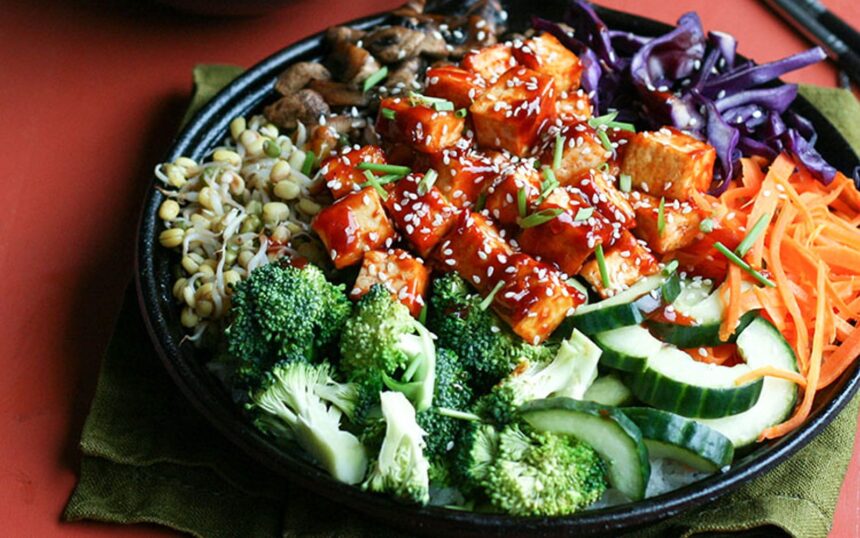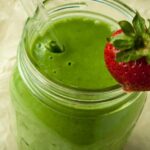Help keep One Green Planet free and independent! Together we can ensure our platform remains a hub for empowering ideas committed to fighting for a sustainable, healthy, and compassionate world. Please support us in keeping our mission strong.
Have you heard of gochujang? It’s a bright, red spicy red chili paste that is very similar to African harissa in the way that it is used. You may have seen it before —it often comes in a plastic red tub or tube and can most likely be found in the international aisle of some grocery stores. Like gochujaru, a spicy chili powder used to make kimchi, gochujang is considered one of the backbone ingredients of Korean cooking. If you love the spicy flavors of Korean cuisine, you might want to consider adding gochujang to your pantry.
About Gochujang
 Thanthima Lim/Shutterstock
Thanthima Lim/Shutterstock
Gochujang is a spicy paste made from red chilis, fermented soy beans, glutinous rice (also known as sticky rice), salt, and sometimes sweeteners. It has a thick, sticky texture and a very spicy, complex flavor. The chili peppers add lingering heat, the glutinous rice brings a subtle sweetness, and the fermented soy beans add an umami flavor. Umami is the taste sensation that makes foods savory, complex and deeply flavorful. It is also important to note that the level at which you experience each flavor component depends entirely on the brand of gochujang you use.
How to Cook With Gochujang

Although gochujang and Sriracha are both bright red spicy chili-based condiments, don’t try to drizzle gochujang on everything because the flavor is very strong. It is best used to enhance flavors of sauces, marinades, and broths. Gochujang is very similar to miso paste in that it can be used to add umami flavor to food, but it is also very versatile. Traditionally, it has been used as part of the marinade for bulgogi, or a Korean dish consisting of grilled meat that is marinated in soy sauce, sugar, sesame oil, garlic, pepper, and sometimes scallions and mushrooms.
The mushrooms in these vegan Mushroom Bulgogi Spring Rolls have been marinated in a sweet, umami sauce and then served with a gochujang-based dipping sauce on the side. You can also try adding a teaspoon of gochujang to the sauce of this Vegetable Protein Bulgogi. Remember, when adding gochujang to dishes, a little bit goes a long way, so it is always best to add it gradually because you can always add more, but you can’t take it out.
Gochujang is also used to make a sauce that is served on the side with bibimbap, a Korean rice dish served in a stone bowl and topped with vegetables, sliced meat, and a fried egg. Try this healthier meat-free Bangin’ Korean Bibimbap that replaces meat with marinated Shiitake mushrooms. Dakdoritang, a fiery-tasting Korean stew made with chicken and potatoes, uses a base of gochujang, green onions, and garlic. This No-Dak-Doritang leaves out the chicken and adds mushrooms and cauliflower instead and is delicious!
You don’t have to stick to traditional recipes when it comes to using gochujang. Try using it as a marinade for vegetables and plant-based meats like tofu, tempeh, and seitan by substituting Sriracha for gochujang in the Simple Asian Marinade from The Ultimate Guide to Making Flavor-Packed Marinades for Plant-Based Dishes. You can also try adding it to the broth in your stews. This guide on How to Make Simple Veg Stews is a great resource for learning how to make your own stews from scratch. Again, just keep in mind that a little bit of this spicy chili paste will go a long way.
Where to Buy

Gochujang is becoming more popular lately, so you might have luck finding it in the international aisle of your local grocery store. Or if you live near an Asian grocery store, you will be able to find it there. If neither of these options suits you, there are plenty of options available online. This Wholly Gochujang, Premium Gluten-free Unpasteurized Artisanal Korean Hot Pepper Paste is made with non-GMO ingredients, contains no chemical additives or preservatives, and according to the company, it is left “unpasteurized to preserve beneficial bacteria.” It costs $18.89 for a 19.7-ounce jar.
Gochujang in a tub is one of the most popular forms. You can get this 17.6-ounce tub of Sunchang Hot Pepper Paste Gold for $7.99. If you prefer pastes in a squeeze tube, try this Sunchang Gochujang Tube. It’s $5.27 for a convenient 60-gram squeeze tube. Both of these products are made by a brand that has been a staple in Korean cooking for decades.
Or, for something that’s on the sweeter side, try this 11.5-ounce bottle of bibigo Go-Chu-Jang Sauce, which is also great for drizzling as it’s a sauce rather than a paste.
More Recipes Using Gochujang!

If you’re just getting started cooking with gochujang, try simple recipes like this Baked Gochujang Tofu. All you need to do is press, marinate, and bake the tofu. Whatever you do, don’t skip pressing the tofu! Pressing is an important step in cooking with tofu; it squeezes the water out so that it can be replaced by marinade resulting in flavorful tofu. Read more in 10 Easy Tips to Troubleshoot Tofu Recipes. This Spicy Tofu and Brussels Sprouts Stir-Fry With Korean-Style Sauce is another great beginner dish, as is this Korean-style spicy Tofu and Sesame Cucumbers. In traditional bibimbap dishes, gochujang sauce is served on the side, but in this Cast Iron Skillet Bibimbap, tofu is fried with garlic and onions in a gochujang-based sauce that’s on the sweeter side.
Try it as a sauce in noodle dishes like Cold Udon Noodles With Spicy Bibimbap Sauce and this Korean Peanut Noodles With Vegetables and Tofu.
Gochujang is great for combining elements of different cuisines. These Korean Spicy Sweet Potato Falafel Tacos With Kimchi are stuffed with gochujang-infused sweet potato falafel, drizzled with a gochujang-based sauce, and topped with kimchi. Try drizzling that same sauce on these Mushroom Bulgogi Lettuce Wraps to give the dish some heat.
Don’t limit yourself to where you add gochujang! The kitchen is always a wonderful place to try old classics and invent new traditions.
Learn How to Cook Plant-Based Meals at Home
Reducing your meat intake and eating more plant-based foods is known to help with chronic inflammation, heart health, mental well-being, fitness goals, nutritional needs, allergies, gut health, and more! Dairy consumption also has been linked to many health problems, including acne, hormonal imbalance, cancer, and prostate cancer, and has many side effects.
For those of you interested in eating more plant-based we highly recommend downloading the Food Monster App — with over 20,000 delicious recipes it is the largest plant-based recipe resource to help reduce your environmental footprint, save animals, and get healthy! And, while you are at it, we encourage you to also learn about the environmental and health benefits of a plant-based diet.
Here are some great resources to get you started:
For more Animal, Earth, Life, Vegan Food, Health, and Recipe content published daily, subscribe to the One Green Planet Newsletter! Lastly, being publicly funded gives us a greater chance to continue providing you with high-quality content. Please consider supporting us by donating!





![Pumpkin Ravioli [Vegan] – One Green Planet](https://top-100-recipes.com/wp-content/uploads/2025/11/pasta-150x150.jpg)

![Mini Pumpkin Rice Cakes [Vegan, Gluten-Free] – One Green Planet](https://top-100-recipes.com/wp-content/uploads/2025/11/xMini-Pumpkin-Rice-Cake-02-150x150.jpg.pagespeed.ic.JYLd6ouW3e.jpg)
![Roasted Brussel Sprouts with Fennel and Pomegranate Seeds [Vegan] – One Green Planet](https://top-100-recipes.com/wp-content/uploads/2025/11/5-thanksgiving-ideas-roasted-brussel-sprouts-with-fennel-and-pomegranate-seeds_www-8thandlake-150x150.jpg)
